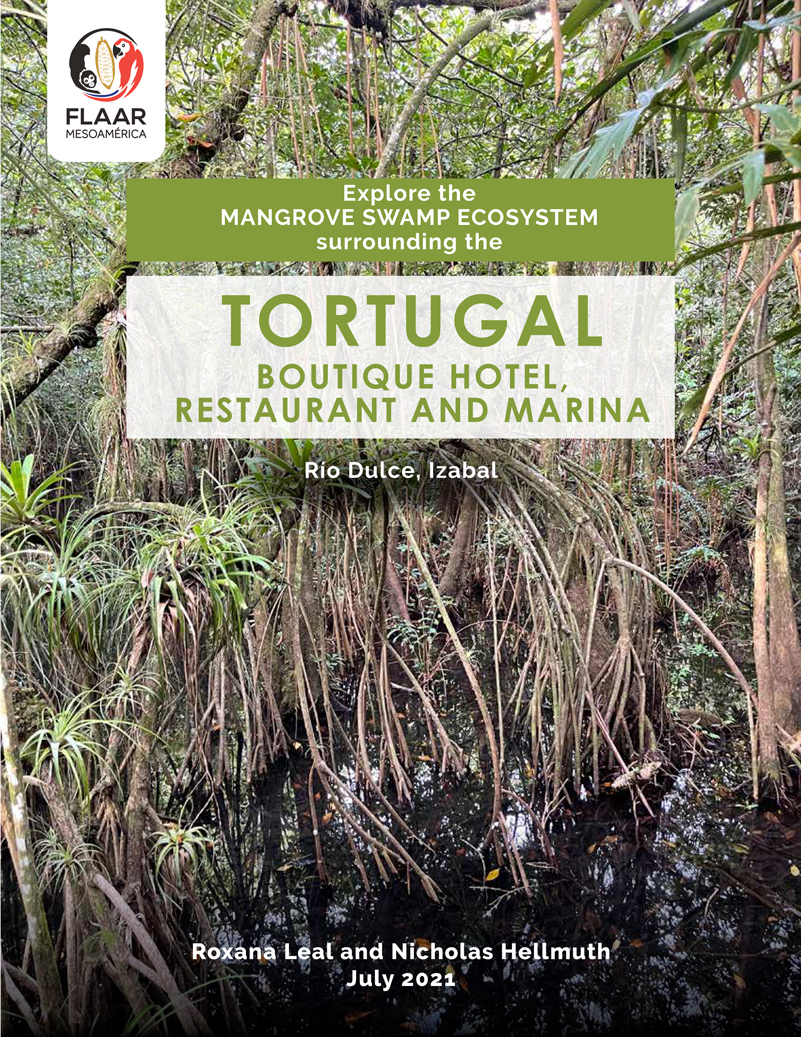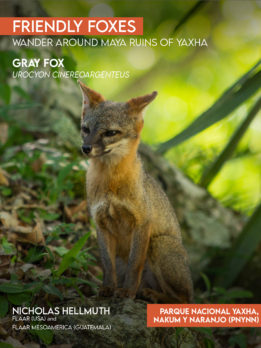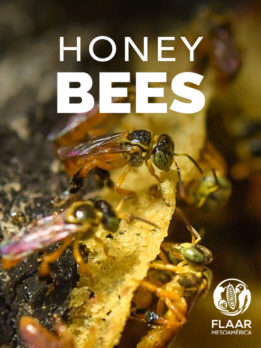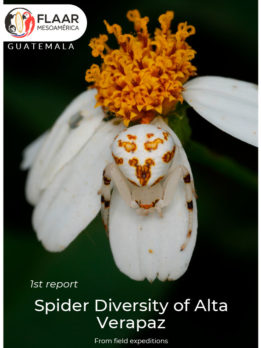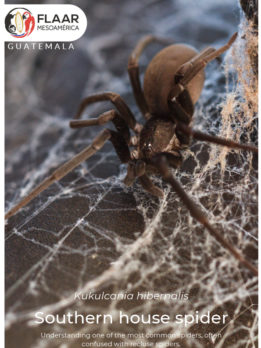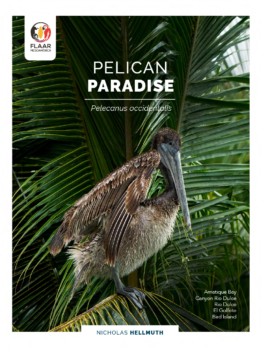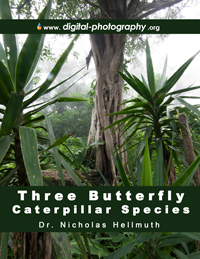We allow, even encourage, insects and arachnids to live outside AND INSIDE the FLAAR office
During the years that we stored maize inside the office, we had so many gorgojo insects that spiders were super happy. Daddy Longlegs type of spiders lived in the bathroom. They must have enjoyed the humidity. Other kinds of spiders set up housekeeping behind ever single photograph or handicraft hung on the wall (we like to have locally made baskets and other woven-fiber materials as display).
Once we moved the maize all outside, the spider population dropped a bit, but they still feed on cockroaches which make the mistake of wandering too close to their nests.
Outside in the garden many kinds of spiders spin their webs (the spiders inside tend to have a mass of spider silk, not a neat web).
Scorpions wander around inside the office, though I will admit that when I see one I usher it outside! One scorpion was in my bathtub; because of the high sides it could not climb out.
Tailless whip scorpions live on the lower levels (the facility is on the edge of a steep hill, so the building steps up the hill in six levels but a total of three full floors). Since tailless whip scorpions are harmless we ask the office staff not to exterminate them. To document they are not harmless, we let them crawl on my hands; the photographer, Erick Flores (one of the capable photographers at FLAAR) does the same.
Maya Bees and Wasps
I especially like bees and wasps. We allow all species of wasps to build their nests wherever they wish. Of course many wasps build their nests stuck to a window. We had two large colonies of that kind. The other kinds of wasps build hanging nests. These are easier to see all sides.
So far I have never been stung by any wasp even when within several inches of their nest. In fact sometimes I need to move the branch a bit to get a better angle to photograph them. Even if a wasp lands on my hand or arm, they do not sting me. Why?
Very simple, the wasps can sense whether someone is trying to harm them (such as knock down their nest). Then they attack, en masse. But they get used to a person if they see the person frequently and this individual does not bother them.
Same with bees. When I am out in the remote areas and happen to find a Melipona or Trigona bee nest, they attach instantly and automatically. They attack because they have never seen me before and they realize that most humans will want to destroy their tree or their nest.
Even though these are all stingless bees, they attack your ears, your nostrils, they burrow down through your hair. These bees are very effective in driving you away. So either I use a telephoto lens, or I simply let them get used to me and then use a macro (close-up) lens.
Ants everywhere
If I leave any cup of tea on my desk unattended for more than 10 minutes, when I return the inside top centimeter is filled with ants. It’s like the images of animals in Africa surrounding the remaining water holes.
The species of ant which most surprised me are the leaf-cutting ants. They had their nests outside our property, with their nest entrances in the cracks in the sidewalk and in the edge of the street. But when they repaved the street, we lost a lot of zompopos.
The ants would hike under the gate and then wander around our garden looking for flowers or leaves to cut. They are fully welcome since in the Neotropics a garden grows fast enough to overcome a few leaf-cutting ants.
The Popol Vuh (ancient book of the Mayan people) states that leaf-cutting ants were used by the Hero Twins to collect flowers from the garden of the death demons, deities, and devils of Xibalba. And indeed the zompopos do cut, collect, and carry flowers back to their nests. Of course they also carry leaves.
Considering the altitude of 1500 meters above sea level, I am surprised to find zompopos here in the suburbs of Guatemala City.
Reptiles and Amphibians
We had turtles outside for several years; we provided water for them; they liked to simply rest underwater much of the day. The rest of the time they spent buried under the leaves and vines which crisscross this particular garden (the one at the back of the building). In other words, we do not keep them in cages. We suspect that the opossums killed and ate two of them.
These turtles we did not correct from rivers; they belonged to people who no longer wanted them inside their homes, and they knew if brought to FLAAR we would have them free to wander around outside (if let loose outside the city they would probably die or be eaten rather quickly).
We had Bufo marinus toads to study them: they were somehow able to dig down so deep that they could cross under walls and get into areas we did not expect they could reach. But either the altitude or other eco-system aspects evidently this is not their proper habitat.
I am not familiar with any frogs native to the bosque seco but surely there are some. However I don’t hear about frogs being in people’s yards. But surely they are in nearby forests.
There is one common species of tiny snake; the young are the size of a large worm. Even when adult they are not very large. The neighbors next door said they wanted to get rid of all snakes and all insect nests so they set fire to an entire grove of bamboo which was the living fence between our property. They thought they were going just to burn out the root area (where evidently lots of snakes lived).
Of course the bamboo trunks caught fire and flames rose to the height of a 4-story building (since the bamboo were the height of a two or three story building). The flames made so much noise they woke me up (at 4 am in the morning). The fire department had to let the fire burn itself out; they simply hosed down the nearby buildings to protect them.
I was sad to lose the living fence but since bamboo are not native, by getting rid of them we were able to plant lots of interesting local vines, bushes, and other species that I wanted to study.
Mammals in the garden are squirrels and opossums
The opossums wander around mainly at night. You can hear them walking across the roof. Many urban areas have opossums or raccoons. As a child in St Louis, Missouri, I can remember seeing rabbits wandering around outside, both in the alley and on people’s lawns.
We love the squirrels. We leave the doors open and put peanuts inside the office. The squirrels have come inside so often that they even found where we stored the nuts (up on the desk of Melanie, one of the illustrators).
One squirrel has opened a space in the mosquito screen of our dining area (with up to 30 people working at FLAAR we had to build two new dining areas: one for the FLAAR Reports team who work on wide-format inkjet printer technology at trade shows around the world; and then a larger dining area for the 15+ illustrators and researchers who help prepare our children’s books.
You can see the MayanToons team and the dining area on www.Facebook.com/mayantoons/
You can see the FLAAR Reports editors and web master team on www.facebook.com/FLAAR.Reports/
Birds everywhere, singing from 4:30 am onward
If I go to sleep early (after a minimum 12-hour work day I often realize I need to get rest by 8 pm) then by 5 am the birds around the building have woken me up. These birds start about 4:30 am. Fortunately it is not as loud as a rooster, but the birds sing continuously. Literally non-stop. Later in the day other species start singing. It is a veritable symphony.
Often I simply walk outside to get exercise and get myself away from my desk. I see butterflies flittering everywhere. The stingless bee hive is near the ground so the bees rise in a diagonal path to reach the flowers. You can actually see their diagonal “highway” as they fly back and forth so neatly.
Then sometimes you can see hummingbirds flitting around. There are bats at night though we rarely see them.
12 months out of the year some flower, vine, or tree is flowering.
And surrounding all this, the birds singing their songs to each other.
First Posted May 2017

















